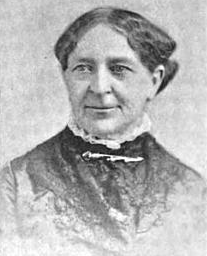The New England Women's Club (est. May 1868) of Boston, Massachusetts, was one of the two earliest women's clubs in the United States, having been founded a couple of months after Sorosis in New York City.[1][2]


History
editHarriet Hanson Robinson, founder of the National Woman Suffrage Association of Massachusetts, and suffragist Caroline Severance worked with Julia Ward Howe to organize the club.[1][3]
In 1868, "club rooms were first secured in ... the rear of the popular Tremont House. On May 30, 1868, the first meeting to introduce the New England Woman's Club to the public was held in Chickering Hall."[2] The club incorporated in 1887; Sarah H. Bradford, Ednah Dow Littlehale Cheney, Lucy Goddard, Abby W. May, L. M. Peabody, Harriet M. Pittman, Harriet Winslow Sewall, and Kate Gannett Wells served as signatories. By 1893, some 340 members belonged to the club. [4] Publisher and activist Josephine St. Pierre Ruffin was the first African-American woman to join the organization, when she joined in the mid-1890s.[5]
Although the club was run by and for women, men were allowed to join. A few men had attended the initial meeting, including Ralph Waldo Emerson, James Freeman Clarke, Octavius Brooks Frothingham, Thomas Wentworth Higginson, and Amos Bronson Alcott.[2] Of these, Emerson, Clarke, and Higginson all became members.[6]
At this time, in Boston, there existed a few other clubs for women, including "the Saturday Morning Club, the Brains Club and the Young Ladies Club, the members of which are in general high-toned persons, interested in intellectual and philanthropic matters."[7] The goal of the New England Women's Club was to "provide a suitable place of meeting in Boston for the convenience of its members, and to promote social enjoyment and general improvement." Committees oversaw club activities with regard to "Art and Literature," "Discussions," "Education," and "Work." "Monday Teas" were held every week.[8] In its first year, club members set about organizing a horticultural school.[9]
Lectures occurred frequently, given by both club members and invited speakers. Among the many lecturers in the club's first decades were: Louis Agassiz, Amos Bronson Alcott, George Thorndike Angell, Richard Henry Dana Jr., Ralph Waldo Emerson, Annie Adams Fields, James T. Fields, William Lloyd Garrison, Edward Everett Hale, Thomas Wentworth Higginson, Oliver Wendell Holmes Sr., Henry James, and Mary Tyler Peabody Mann.[4]
Buildings
editAround 1903, the club moved its headquarters from Park Street to the newly constructed New Century Building on Huntington Avenue, designed by architect Josephine Wright Chapman.[10] In 1909, the club moved into the newly constructed Chauncy Hall Building at 585 Boylston Street, and it was there as late as 1922. [11] [12]
Notable members
edit- Ednah Dow Littlehale Cheney[1]
- Adelaide Avery Claflin
- Sarah Stoddard Eddy
- Julia Ward Howe[1]
- Harriet Ann Jacobs
- Rebecca Richardson Joslin
- Mary Livermore
- Lucretia Mott
- Elizabeth Palmer Peabody
- Harriet Hanson Robinson
- Josephine St. Pierre Ruffin
- Caroline Severance[1][2][13]
- Harriet Winslow Sewall
- Lucy Stone.[4][6][14]
- May Alden Ward
- Kate Gannett Wells
References
edit- ^ a b c d e The Encyclopedia Americana: A Library of Universal Knowledge, vol. 2, 1920, p. 466.
- ^ a b c d Ella Giles Ruddy, ed. The Mother of Clubs: Caroline M. Seymour Severance: An Estimate and an Appreciation. Baumgardt Pub. Co., 1906
- ^ Emerson, Dorothy May; Edwards, June; Knox, Helene (2000). Standing Before Us: Unitarian Universalist Women and Social Reform, 1776-1936. Unitarian Universalist Association of Congregations. p. 82. ISBN 978-1-55896-380-1. Retrieved 2012-07-02.
- ^ a b c Julia A. Sprague. History of the New England Women's Club from 1868 to 1893. Boston: Lee & Shepard, 1894
- ^ "Josephine St. Pierre Ruffin (1842-1924)". August 26, 2012.
- ^ a b Helen M. Winslow. "The Story of the Woman's Club Movement". New England Magazine, July 1908.
- ^ Georgia Weekly Telegraph, Feb. 9, 1875.
- ^ New England Women's Club. Act of Incorporation. 1887.
- ^ New England Woman's Club Anniversary. New York Herald, May 30, 1869.
- ^ Helen M. Winslow. "The Boston Women's Club House". The Delineator, Butterick Publishing Co., 1903.
- ^ “Enters New Home,” Boston Globe, January 5, 1909, 10.
- ^ The Boston Register and Business Directory 1922 (Boston: Sampson & Murdock Company, 1922), 601.
- ^ "Mother of Women's Clubs Dead". New York Times, November 11, 1914.
- ^ Daily Inter Ocean (Chicago), April 20, 1889.
Further reading
edit- C.P. Cranch. Ode; read at the festival celebrating the birthday of Margaret Fuller Ossoli, held by the New England Women's club, Boston, May 23, 1870. Atlantic Monthly, Aug. 1870.
- J.C. Croly. "New England Woman's Club." The history of the woman's club movement in America. NY: H. G. Allen & Co., 1898; p. 35+ Published under the authority of the General Federation of Women's Clubs
- Ednah Dow Cheney, 1824-1904: memorial meeting, New England Women's Club, Boston, February 20, 1905. Boston: Geo. H. Ellis Co., printers, 1905.
External links
edit- Harvard University New England Women's Club. Records, 1843-1970: A Finding Aid.
- Boston Athenaeum. Dickens party at the New England Woman’s Club, 1905; photo by Elmer Chickering. "Group portrait taken at a party at which club members dressed in costume as characters from the novels of Charles Dickens. Handwritten key on verso identifies three of the members as Mrs. Julia Ward Howe, the hostess, who founded the club in 1868; Mrs. Daniel Lothrop dressed as Betsey Trotwood; and Mrs. Leo Hunter."